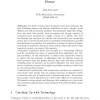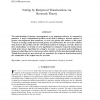322 search results - page 2 / 65 » On the Complexity of Reverse Similarity Search |
SOFSEM
2000
Springer
13 years 11 months ago
2000
Springer
For half a century since computers came into existence, the goal of finding elegant and efficient algorithms to solve "simple" (welldefined and well-structured) problems ...
VLDB
2001
ACM
13 years 12 months ago
2001
ACM
Complex similarity queries, i.e., multi-feature multi-object queries, are needed to express the information need of a user against a large multimedia repository. Even if a user in...
DASFAA
2008
IEEE
14 years 1 months ago
2008
IEEE
Similarity search in complex databases is of utmost interest in a wide range of application domains. Often, complex objects are described by several representations. The combinatio...
JCB
2007
13 years 7 months ago
2007
The understanding of genome rearrangements is an important endeavor in comparative genomics. A major computational problem in this field is finding a shortest sequence of genome...
CEC
2009
IEEE
14 years 2 months ago
2009
IEEE
— Regulatory networks are complex networks. This paper addresses the challenge of modelling these networks. The Boolean representation is chosen and supported as a representation...


